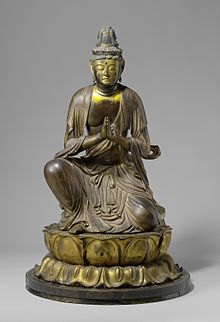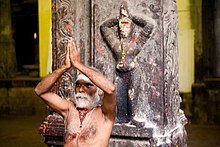Añjali Mudrā
Some of this article's listed sources may not be reliable. (September 2023) |


Añjali Mudrā (Sanskrit: अञ्जलि मुद्रा) is a hand gesture mainly associated with Indian religions and arts, encountered throughout Asia and beyond. It is a part of Indian classical dance postures such as Bharatanatyam,[1] yoga practice,[2] and forms part of the greeting Namaste. Among the performance arts, Anjali Mudra is a form of non-verbal, visual communication to the audience. It is one of 24 samyukta mudras of the Indian classical arts.[1] There are several forms of the Anjali Mudra such as the brahmanjali.[3]
The gesture is incorporated into many yoga asanas.[2] The modern yoga pose praṇāmāsana (Sanskrit: प्रणामासन) involves standing upright, with the hands in Añjali Mudrā.
As a gesture, it is widely used as a sign of respect or a silent greeting in India, Sri Lanka, Nepal, Bhutan, Burma, Thailand, Laos, Cambodia, Indonesia and Malaysia. It is also used among East Asian Buddhists, Chinese religionists, and Shintoists and adherents of similar Asian traditions. The gesture is used as a part of prayer or for worship in many Indian religions and other Eastern religions.
In sculpture, the Anjali mudra is common at entrances and in relief works of historic temples such as the Lingobhavamurti of Shaivism.[4][5] The Anjali mudra differs from Namaste by being a non-verbal gesture, while Namaste can be said with or without any gesture. According to Bhaumik and Govil, the Anjali mudra and Namaskara mudra are very similar but have subtle differences. The back of the thumbs in Anjali mudra face the chest and are perpendicular to other fingers, while the thumbs in Namaskara mudra are aligned with the other fingers.[6]
Etymology
[edit]Añjali (अञ्जलि) is a Sanskrit word which refers to the cavity formed between the palms by folding the hands together, to thus hold and offer flowers or water or donate or to receive something.[3][7] When the hands press together and are raised, it connotes "respect", "reverence", "benediction", "salutation" or a form of "supplication".[3][7] It is derived from anj, meaning "to honour or celebrate".[8] Anjali connotes a "divine offering", "a gesture of reverence".[8]
Mudra means "seal" or "sign". The meaning of the phrase is thus "salutation seal".[9]
Anjali mudra is described in ancient Indian texts such as in verse 9.127–128 of the Natya Shastra (200 BCE – 200 CE), in temple architecture texts dated after the 6th-century CE such as in verse 5.67 of the Devata murti prakarana, and those on a painting called the Citrasutras. The Natya Shastra, a classical Indian dance text, describes it to be a posture where the two hands are folded together in a reverential state and that this is used to pray before a deity, receive any person one reveres, and also to greet friends. The Natya Shastra further states that for prayers inside a temple, the Anjali mudra should be placed near one's head or above, while meeting someone venerable it is placed in front of one's face or chin, and for friends near one's chest.[10][11]
The gesture is also known as hrdayanjali mudra meaning "reverence to the heart seal" (from hrd, meaning "heart") and atmanjali mudra meaning "reverence to the self seal" (from atman, meaning "self").[8]
Description
[edit]
Anjali mudra is performed by pressing the palms of the hands together. The fingers are together with fingertips pointing up. The hands are pressed together firmly and evenly.[8]
In the most common form of Anjali mudra, the hands are held at the heart chakra with thumbs resting lightly against the sternum.[8] The gesture may also be performed at the Ajna or brow chakra with thumb tips resting against the "third eye" or at the crown chakra (above the head). In some yoga postures, the hands are placed in Anjali mudra position to one side of the body or behind the back.
Anjali mudra is normally accompanied by a slight bowing of the head.
Symbolic meaning
[edit]
Anjali mudra has the same meaning as the Sanskrit greeting Namaste and can be performed while saying Namaste or Pranam, or in place of vocalizing the word.
The gesture is used for both greetings and farewells but carries a deeper significance than a simple "hello" or "goodbye". The joining together of the palms is said to provide a connection between the right and left hemispheres of the brain and represents unification.[8][9] This yoking is symbolic of the practitioner's connection with the divine in all things. The word Namaste is sometimes translated as "I bow to the divinity within you, from the divinity within me."[9]
In Sri Lanka the Sinhalese gesture of welcome incorporates the words "ayubowan" (may you live long) with both hands placed together on the sternum with a slight bow.
Physical benefits
[edit]Anjali mudra is performed as part of a physical yoga practice with the aim of achieving several benefits. It is a "centering pose" that, according to practitioners, helps to alleviate mental stress and anxiety, and is therefore used to assist the practitioner in achieving focus and coming into a meditative state.[8]
The physical execution of the pose helps to promote flexibility in the hands, wrists, fingers, and arms.[8]
Use in full-body asanas
[edit]While anjali mudra may be performed by itself from any seated or standing posture, the gesture is also incorporated into physical yoga practice as part of many full-body asanas including:
- Anjaneyasana (lunge) – with arms overhead[12]
- Hanumanasana (monkey pose)[13]
- Malasana (garland pose)[14]
- Matsyasana (fish pose) – an advanced variant[15]
- Prasarita Padottanasana (wide-legged forward bend) – an advanced variant with hands behind the back[16]
- Rajakapotasana (Pigeon Pose/King Pigeon Pose) – anjali mudra in Pigeon pose[17]
- Tadasana/samasthiti (mountain pose) – a variant of the pose used during sun salutation sequences[18]
- Utkatasana (chair pose, literally "fierce pose"), arms overhead
- Urdhva Hastasana (upward salute/extended mountain pose) – arms overhead[19]
- Virabhadrasana I (warrior I) – arms overhead[20]
- Vrikshasana (tree pose)[21]
See also
[edit]- Anjali is known as 合掌 in East Asia, pronounced as Gassho in Japanese, hézhǎng in Mandarin, habjang[haptɕaŋ] in Korean and hiệp chưởng in Vietnamese.
- List of mudras
- Mingalaba
- Namaste
- Pranāma
- Sembah
- Sampeah
- Thai greeting
- Wai
References
[edit]- ^ a b Anami, Basavaraj S.; Bhandage, Venkatesh A. (2018-06-04). "A vertical-horizontal-intersections feature based method for identification of bharatanatyam double hand mudra images". Multimedia Tools and Applications. 77 (23). Springer Science: 31021–31040. doi:10.1007/s11042-018-6223-y. ISSN 1380-7501. S2CID 254827995.
- ^ a b C Carroll; R Carroll (2012). Mudras of India: A Comprehensive Guide to the Hand Gestures of Yoga and Indian Dance. SD Publishers. pp. 44–46. ISBN 978-0-85701-067-4.
- ^ a b c Jan Gonda (1980). Handbuch Der Orientalistik: Indien. Zweite Abteilung. Brill Academic. pp. 65–67, 126–130. ISBN 9789004062108.
- ^ Douglas Barrett (1964). "An Early Cola Lingodbhavamurti". The British Museum Quarterly. 28 (1/2 (Summer)): 32–39. JSTOR 4422848.
- ^ Stella Kramrisch (1957). "Indian Sculpture Newly Acquired". Philadelphia Museum of Art Bulletin (Winter). 52 (252): 30-38 with Fig 2 and 3. doi:10.2307/3795036. JSTOR 379036.
- ^ Bhaumik, Gopa; Govil, Mahesh Chandra (2020). "Buddhist Hasta Mudra Recognition Using Morphological Features". Communications in Computer and Information Science. Singapore: Springer Singapore. pp. 356–364. doi:10.1007/978-981-15-6315-7_29. ISBN 978-981-15-6314-0. ISSN 1865-0929. S2CID 225349190.
- ^ a b VS Apte (1965). Practical Sanskrit-English dictionary. Motilal Banarsidass. p. 25. ISBN 9780895811714.
- ^ a b c d e f g h "Salutation Seal". Yoga Journal. Retrieved 2002-06-12.
- ^ a b c Rea, Shiva. "For Beginners: Anjali Mudra". Yoga Journal. Archived from the original on 11 June 2009. Retrieved 2009-06-12.
- ^ Isabella Nardi (2003). The Theory of Indian Painting: the Citrasutras, their Uses and Interpretations. SOAS, University of London. pp. 132–134, also see Figure 67 on page 273.
- ^ James R. BRANDON (2009). Theatre in Southeast Asia. Harvard University Press. pp. 137–139. ISBN 9780674028746.
- ^ "Low Lunge". Yoga Journal. 5 May 2008. Retrieved 2009-06-12.
- ^ "Monkey Pose". Yoga Journal. 28 August 2007. Retrieved 2009-06-12.
- ^ "Garland Pose". Yoga Journal. 28 August 2007. Retrieved 2009-06-12.
- ^ "Fish Pose". Yoga Journal. 28 August 2007. Archived from the original on 18 June 2009. Retrieved 2009-06-12.
- ^ "Wide-Legged Forward Bend". Yoga Journal. Archived from the original on 11 June 2009. Retrieved 2009-06-12.
- ^ "Pigeon Pose". Yoga Journal. 16 July 2008. Retrieved 2009-06-12.
- ^ "Mountain Pose". Yoga Journal. Retrieved 2009-06-12.
- ^ "Upward Salute". Yoga Journal. 19 February 2008. Retrieved 2009-06-12.
- ^ "Warrior I". Yoga Journal. Archived from the original on 31 May 2009. Retrieved 2009-06-12.
- ^ "Tree Pose". Yoga Journal. Archived from the original on 2 May 2009. Retrieved 2009-06-12.
===
합장

합장(合掌, 산스크리트어: अंजलि)은 가슴 앞에서 손바닥을 합쳐 좌우 열 손가락을 펴서 포개는 일은 불교에서뿐만 아니라 옛날부터 행해진 인도의 일상적인 인사법이다. 이 예법은 승려와 신자 사이에 행하는 인사법이었으며 불타와 보살에 대한 예배의 방법이다. 이렇게 함으로써 자신의 마음이 불타와 보살에 전념하고 있음을 나타내는 것이다. 가톨릭 교회의 합장에서는 왼손과 오른손의 손바닥을 마주대고 오른손 엄지손가락을 왼손 엄지손가락 위에 십자모양으로 교차시켜 얹는다. 정교회, 성공회, 개신교 등 많은 기독교도 비슷한 동작이 있다.
같이 보기
[편집]| . |
==
合掌

合掌(がっしょう、サンスクリット: अञ्जलि, Añjali)とは、インド起源の礼拝の仕草。両手のひらを胸または顔の前で合わせる。
概説
[編集]右手は仏の象徴で、清らかなものや知恵を表す。左手は衆生、つまり自分自身であり、不浄さを持ってはいるが行動力の象徴である。両手を合わせることにより、仏と一体になることや仏への帰依を示すとされる。
仏教徒は、あらゆる挨拶において合掌をするが、特に他人に向かって合掌をすることは、その者への深い尊敬の念を表す。
アジア以外(特に欧米)ではしばしば挨拶のつもりで極東の東洋人(日本人・中国人・韓国人など)に向かって合掌しお辞儀をするものがいるが、僧以外の一般人が日常の挨拶として合掌をするのは東南アジアや南アジアの一部の国や地域(インドのナマステやタイのワイなど)に限られる。このステレオタイプはアメリカをはじめとするメディア(娯楽番組・映画・アニメなど)にしばしば登場する。
日本では仏教に関する儀式の際に行われるだけでなく、お詫びをするときやお願いをするときに、相手を持ち上げるための仕草として使う例もある。また、食前食後の挨拶の際に合掌する例もあるが、これは仏教由来の習慣である。神道では柏手として手を打ち合わせるが、その後は両手を下ろし、お辞儀して礼拝する(神道の拝礼では、合掌はしない)。
合掌の種類
[編集]- 堅実心合掌 - 最も一般的な合掌。両手の平および指をまっすぐに伸ばしてずれや隙間のないようにぴったりと合わせる。素直で偽りのない祈りの心を表現するとされる。
- 虚心合掌 - 手の平と手の平の間に、少し隙間ができるように合わせる。子どものような穢れのない心を表現するとされる。
- 金剛合掌 - 指を少し開き、交互に組むようにして右手を上に手の平を合わせる。左手を上にする人もいるがそれは正しくない。より強い仏への帰依を表すとされ、帰命(きみょう)合掌とも呼ばれる。
片手で行う略礼という形式もある。
関連項目
[編集]==
합장
|

合掌(굿쇼, 산스크리트 : अञ्जलि, Añjali )는 인도 기원의 예배 행위. 양손바닥을 가슴이나 얼굴 앞에 맞춘다.
개요
[ 편집 ]오른손은 부처님 의 상징으로 깨끗한 것이나 지혜를 나타낸다. 왼손은 중생 , 즉 자기 자신이며, 불결함을 가지고는 있지만 행동력의 상징이다. 양손을 맞추는 것으로, 부처와 일체가 되는 것이나 부처에의 귀의를 나타낸다고 한다.
불교도는 모든 인사에서 합장을 하지만, 특히 타인을 향해 합장을 하는 것은 그 사람에 대한 깊은 존경의 뜻을 나타낸다.
아시아 이외(특히 구미 )에서는 종종 인사할 생각으로 극동 의 동양인 ( 일본인 · 중국인 · 한국인 등)을 향해 합장 인사 를 하는 것이 있지만, 스님 이외의 일반인이 일상의 인사로서 합장 하는 것은 동남아시아 나 남아시아 의 일부 국가나 지역( 인도 의 나마스테 나 태국 의 와이 등)에 한정된다. 이 스테레오 타입 은 미국 을 비롯한 미디어 ( 엔터테인먼트 프로그램 · 영화 · 애니메이션 등)에 자주 등장한다.
일본 에서는 불교에 관한 의식시에 행해질 뿐만 아니라 사과 를 할 때나 부탁을 할 때 상대를 들어올리기 위한 행동으로 사용하는 예도 있다. 또한 식전식후 인사 때 합장하는 예도 있지만, 이것은 불교 유래의 습관이다. 신도 에서는 가시수 로서 손을 협의하지만, 그 후는 양손을 내리고, 절사하고 예배한다(신도의 예배에서는, 합장은 하지 않는다).
합장의 종류
[ 편집 ]- 견실심 합장 - 가장 일반적인 합장. 양손의 평 및 손가락을 똑바로 펴서 어긋남이나 틈이 없도록 딱 맞춥니다. 솔직하고 거짓이 없는 기도 의 마음을 표현한다고 한다.
- 허심합장 - 손바닥과 손바닥 사이에 조금 틈이 생기도록 맞춘다. 아이처럼 귀찮은 마음을 표현한다고 한다.
- 金剛合掌 - 손가락을 조금 열고 교대로 짜서 오른손을 위로 손바닥을 맞춘다. 왼손을 위로 하는 사람도 있지만 그건 옳지 않다. 보다 강한 부처에의 귀의를 나타내는 것으로 여겨져, 귀명 함장이라고도 불린다.
한 손으로 하는 약례라는 형식도 있다.
관련 항목
[ 편집 ]==
==
“손은 원래 둘인 것을 지금 합하여 하나로 하는 것으로
산란하거나 허망하지 않음을 표현하는 것이니,
오로지 한 마음이 되고 그 마음이 기울거나 모자람 없이 하기 때문에
이것으로 공경을 표현하는 것이다” 라고 하여,
합장은 정돈된 마음으로 정성을 다하는 것과 동시에
치우치지 않는 진솔한 마음을 전하는 것을 의미한다.
또한 <법원주림> 20권에는
“율장에 이르기를 마땅히 한 마음으로 열손가락과 손바닥을 붙여 부처님을 공양하게 하고,
또는 차수(叉手)하여 부처님께 사뢴다는 말은 모두 얼굴을 가다듬어 공경을 드러내어
마음이 제멋대로 산란하지 않게 제어하는 것이다.
하지만 산란한 마음을 막기 어렵기 때문에 손을 합하여 한 마음이 되도록 하는 것”
이라고 했다.
무엇보다 합장은 부처님께 공경의 의미이면서
우리들의 마음이 산란하지 않게 단속하는 수행의 의미가 있는 것이다.
합장의 바른 자세는 마음의 간절함과 비례한다.
간절한 만큼 손을 모으고, 지극한 만큼 바른 자세가 나온다.
그래서 합장의 자세는 그 사람의 종교적 신념과 의지의 표현이라고 하는 것이다.
합장은 너와 나의 분별된 마음을 하나로 합쳐 대립과 갈등의 세계를 끝내고
공생공존의 불교 가치를 아주 쉽게 표현하고 실천하는 방법이다.
모든 만남과 인연들을 단아한 합장으로 맞이하자.
모든 인연들이 겸손과 정성으로 거듭나게 될 것이다.
출처/수미산 메일에서
[출처] 합장(合掌)|작성자 목야
